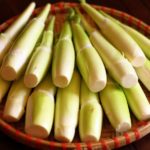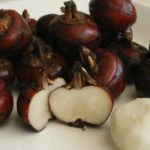The water chestnut (or sedge) is a type of wild grass that is very easy to grow, hardy, and adaptable to different soils. In the past, this plant grew wildly in marshes and rice fields. However, today, the cultivation of this plant has brought prosperity to the people of the Mekong Delta in Vietnam. Let’s learn more about this fascinating plant in the article below!
1 What is the Water Chestnut Plant?
Origin and Significance of the Water Chestnut
 Origin of the Water Chestnut
Origin of the Water Chestnut
The water chestnut, with the scientific name Cyperus Malaccensis Lamk, belongs to the Cyperaceae family. There are three types: white-flowered water chestnut, brown-flowered water chestnut, and three-sided water chestnut.
This plant is native to Southeast Asia, and has since spread westward to regions such as Iraq and India, northward to southern China, and southward to Australia and Indonesia.
In Vietnam, the water chestnut is cultivated in 26 coastal provinces and cities, covering a vast area of 12,869 hectares.
The white-flowered and brown-flowered water chestnuts are mainly grown in three regions: the Red River Delta, the North Central Coast, and the Mekong Delta.
The three-sided water chestnut, on the other hand, is much less common.
Characteristics of the Water Chestnut
The water chestnut is a perennial plant that typically grows in moist environments. Its structure consists of two main parts:
- Underground part: This includes the roots and underground stems.
- Above-ground part: This includes the aerial stems, leaves, flowers, fruits, and seeds.
 Water Chestnuts thrive in moist environments
Water Chestnuts thrive in moist environments
- The roots grow from the nodes of the underground stems and can reach depths of 0.5 to 1 meter. When young, the roots are white, turning brownish-pink as they age, and eventually black when they die.
- The underground stems are formed as the suckers age. This part also has the function of reproduction, as it has eyes that can sprout, as well as storing and reserving energy for the plant’s survival.
- The aerial stems can grow to a height of 1 to 2 meters. They have a three-sided or round cross-section. The pith of the water chestnut is solid and spongy. When young, the stems are a glossy dark green, turning to a pale yellow as they age. The aerial stems of the brown-flowered water chestnut are thicker than those of the white-flowered variety. The three-sided water chestnut has shorter stems, but they are harder and more brittle.
- The leaves of the water chestnut have sheaths that hug the stems, growing from the base to the tip. The leaf blades are narrow and long.
 Water Chestnut flowers are hermaphrodite
Water Chestnut flowers are hermaphrodite
- The flowers of the water chestnut are hermaphrodite (having both male and female organs) and wind-pollinated. They grow in small spikes in the leaf axils and are white or brown in color.
- The fruits of the water chestnut are very small, and the seeds are usually not attached to the fruit. While they have the ability to germinate, they are not commonly used for propagation.
2 Uses of the Water Chestnut
Used for Weaving and Crafts
Water chestnuts are primarily used for weaving mats and producing various handicrafts. From these delicate plants, artisans create thousands of beautiful products such as bags, baskets, sandals, and hats using their creative skills and imagination.
 Water Chestnuts used in handicrafts
Water Chestnuts used in handicrafts
Water chestnut mats are made by drying the thin, fibrous stalks of the plant and then weaving them together using jute threads. To enhance the aesthetic appeal of these mats, artisans often dye the fibers or paint unique patterns on them.
Medicinal Uses
Apart from its use in weaving and handicrafts, the water chestnut is also valued for its medicinal properties. It is used to treat various ailments such as edema, indigestion, abdominal distension, and urinary tract problems. It is also believed to improve appetite in children and strengthen those who are weak and frail.
The underground stems and roots are the parts used for medicinal purposes. These contain 3.1% tannins, 0.7% flavonoids, 0.5% essential oils, and 0.5% alkaloids.
 Medicinal uses of the Water Chestnut
Medicinal uses of the Water Chestnut
In addition to the above-mentioned uses, growing water chestnuts also helps protect dikes and embankments and improves saline soil. The leaves of the plant can be used as fodder for livestock.
3 How to Grow and Care for Water Chestnuts
How to Grow Water Chestnuts at Home
Preparing Water Chestnut Rhizomes
Use water chestnut rhizomes from a healthy, 3- to 5-year-old plant. The ideal sprouts should be 15 to 30 cm tall and 3 to 5 mm in diameter. If you choose to propagate from a mature plant, cut it back to 30 cm in height. Separate the sprouts, leaving 2 to 3 sprouts per clump. Plant the sprouts immediately after separation.
If you are unable to prepare the soil immediately, you can store the sprouts in a cool, shaded area with moist roots for 3 to 5 days. One square meter of sprouts can provide enough planting material for eight square meters of land.
Preparing the Soil
Choose a site with a salinity level of 0.1-0.2%, a pH of 6-7, and a soil depth of at least 50 cm, with a mud layer of 30-40 cm. The bottom layer should not contain white sand. Select a field with easy water control, allowing for convenient drainage and irrigation.
Follow these steps to prepare the soil, ensuring it is loose and free of weeds:
Plough the field to a depth of 18-20 cm, then harrow the soil and flood it with water for a few days to allow weeds to sprout. Harrow the field again, then flood it with water to a depth of 20-25 cm and leave it for 7-10 days.
Next, plough the field again to a depth of 13-15 cm, harrow the soil once more to ensure it is free of weeds, and then flood the field with water to a depth of 10-15 cm for another 7-10 days. Finally, drain the water and harrow the field one last time to level the surface.
Weed Control and Seedbed Preparation
- Apply herbicides 3 to 5 days before planting. Manually remove weeds and place them on the embankment (do not bury them in the mud).
- Use pre-emergent herbicides such as Butanic or Heco at a rate of 40 to 50 ml per 10 liters of water per square meter. After spraying, maintain a water level of 3 to 5 cm for 4 to 5 days to ensure the effectiveness of the herbicide. Avoid water loss, as this can cause the soil to crack and reduce the herbicide’s efficacy.
Creating Irrigation and Drainage Channels
On the field, dig a small ditch about 30 cm wide and 10 to 15 cm deep. Additionally, create drainage channels around the perimeter of the field to facilitate water control and prevent the spread of weeds.
For large-scale production, it is advisable to cultivate water chestnuts in concentrated areas with a system of dikes, canals, and ditches to facilitate water management.
Caring for Water Chestnuts
Weed Control
For newly planted water chestnuts, the first weeding should be done 20 to 30 days after planting, and subsequent weeding should be done as needed, approximately once a month. Using rice husks to cover the field after weeding can help suppress weed growth. After harvesting water chestnuts, it is important to remove all debris and weeds immediately.
Water Management
During the sprouting and branching stage, it is crucial to maintain constant moisture in the field to ensure healthy growth and high-quality roots. The water level should be maintained at 4 to 5 cm during this period.
As the plants grow taller, the water level should be lowered to 2 to 3 cm. Additionally, during this stage, the plants are less tolerant of salinity, so the irrigation water should have a salinity level of 0.08 to 0.25% for optimal growth.
Before harvesting, the field should be drained of water 10 to 15 days in advance. During the ripening stage, it is important to maintain moisture to prevent the plants from falling over. If harvesting is delayed, maintain a water level of 3 to 5 cm.
 Caring for Water Chestnuts
Caring for Water Chestnuts
Notes on Growing and Caring for Water Chestnuts
- Water chestnuts require consistent moisture but should not be waterlogged. The seeds can take a month or more to germinate and are not easily dispersed by themselves. Even in their native habitat, water chestnuts do not readily spread via seeds. They require additional care to thrive, especially in terms of moisture retention.
- If the stems are damaged, they should be cut off. Fertilizing water chestnuts in the spring can promote their growth.
- One of the water chestnut’s enemies is iron rust fungus, which causes the stems and leaves to lose their color.
 Notes on Growing and Caring for Water Chestnuts
Notes on Growing and Caring for Water Chestnuts
4 Beautiful Images of Water Chestnuts
 Water Chestnut Harvest
Water Chestnut Harvest
 Drying Water Chestnuts
Drying Water Chestnuts
 Water Chestnut Field from Above
Water Chestnut Field from Above
 Water Chestnut Harvest Season in the Village
Water Chestnut Harvest Season in the Village

































